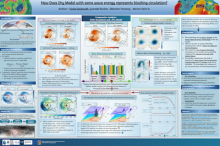How does a dry general circulation model with the same climatology and wave energy as in the observations represent atmospheric blocking?
Vinita
Deshmukh
Laboratoire de Météorologie Dynamique -IPSL
Poster
Atmospheric blockings are large-scale quasi-stationary anomalies that block the mean westerlies and trigger extreme temperature events such as heat waves and cold spells. While the dry dynamics theory has been a key initial framework for understanding blocking mechanisms, recent studies have highlighted the significant role of moist processes in the formation and maintenance of blocking. However, it remains unclear whether moist processes introduce unique characteristics in the blocking life cycle which can not be captured by dry dynamics or they are just a source of extra energy for the atmospheric disturbances forming the blockings. We aim to gain insights into the representation of blocking mechanisms and statistics using the new dynamical core of the General Circulation Model (GCM) developed at IPSL called DYNAMICO. The model also includes a simple forcing in such a way that the model climatology in temperature and wave energy is the same as in ERA5 reanalysis during boreal winter. The blocking statistics in the model and ERA5 are then compared using a PV-based blocking detection. Frequencies of occurrence of blocks are found to be 50% less in the model than in ERA5. This is largely due to too strong westerly background flow in the model, in the North Pacific in particular, which prevents the formation of persistent anticyclones. Despite this underestimation in frequencies of occurrence, the main characteristics of the blocks (intensity, shape, duration) are similar in the model and ERA5. By analyzing backward Lagrangian trajectories from blocked areas, we show how the model is able to compensate for the lack of moisture to get PV anomalies as intense as in ERA5. This study shows that, despite the different processes at play, the main characteristics of the life cycle of observed blockings can be well represented in a dry model.
Acknowledgment: This Project of a part of the EU International Training Network (ITN). EDIPI (European Extreme weather; Drivers, predictability, and impacts). EDIPI is funded under the European Commission’s H2020-MSCA-ITN program.
Acknowledgment: This Project of a part of the EU International Training Network (ITN). EDIPI (European Extreme weather; Drivers, predictability, and impacts). EDIPI is funded under the European Commission’s H2020-MSCA-ITN program.

Poster file
Deshmukh_Vinita_blocking poster .pdf
(4.91 MB)
Meeting homepage
